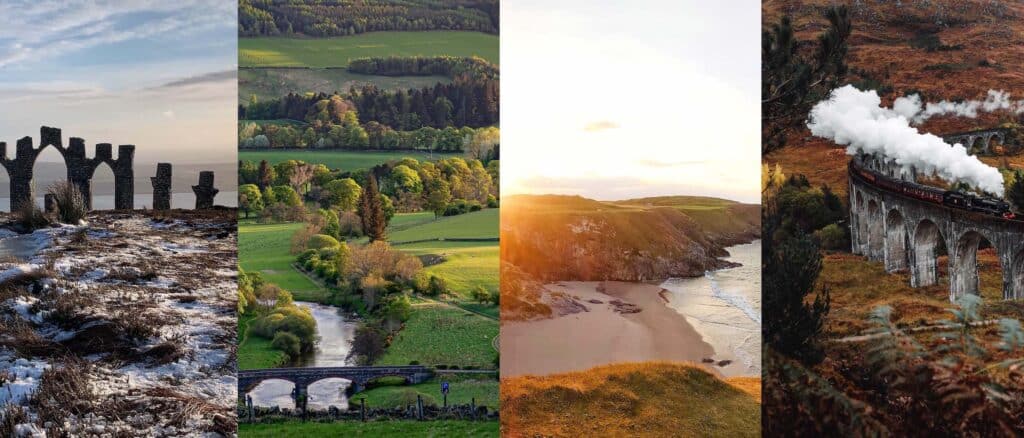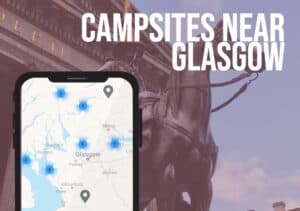Scotland is a stunning destination for camping, offering diverse landscapes, incredible views and an abundance of wildlife. However, camping doesn’t need to be confined to the summer months, with the right gear and knowledge you can camp during each of the four seasons. In this blog post, we’ll explore the ideal time to go camping in Scotland, focusing on the average sunrise/sunset, rainfall, and temperature for each season, along with tips and advice for camping during the off-season. We’ll also share recommendations for the best times to tackle two of Scotland’s most iconic routes: the North Coast 500 and the West Highland Way.
When it comes to Off-Season Camping only a few campsites in Scotland are open, meaning that off-season camping is mostly wild camping. Wild camping is legal in Scotland, but campers must follow the Scottish Outdoor Access Code (found here) and leave no trace. It’s essential to plan your trip carefully, bring appropriate equipment and clothing, and check weather conditions before setting out. We have included 6 campsites that are open all year round, just incase wild camping isn’t your thing.

Spring (March to May)
Spring is an excellent time to go camping in Scotland, with longer daylight hours and mild temperatures. The average temperature during spring ranges from 6°C to 14°C. The sun rises around 6 am and sets around 8 pm. The average rainfall during this season is around 75mm per month. Spring is the perfect season for exploring the Scottish countryside, as the landscape is covered in a blanket of green and wildflowers. This season is perfect for hiking, bird watching, and fishing, with many fish species starting to spawn and become more active.
Mid Spring is one of our favourite times to camp, most the campsites will have just opened, the midges will still be sleeping and the temperature is perfect for hiking or kayaking. If your doing one of the longer hiking trails then mid May is the ideal time (Spey side way, West Highland Way, Hebrides Way).
A sleeping bag with a rating of 0°C to -5°C is best suited to this season.
Summer (June to August)
Summer is peak camping season in Scotland, with long daylight hours, warm temperatures and school holidays it can get very busy so make sure you book ahead where possible. The average temperature during summer ranges from 12°C to 19°C. The sun rises around 4:30 am and sets around 10 pm. The average rainfall during this season is around 90mm per month. Summer is the perfect time to enjoy outdoor activities such as kayaking, canoeing, and mountain biking. This season is also ideal for exploring Scotland’s stunning beaches and coastal landscapes although if the sun is not out those pristine beaches on the west coast and islands can be rather cold. However, be prepared for midges, especially in the Highlands and Islands they can be intolerable at times. Make sure you pack a midgie net, some Smidge insect repellant or plenty fire wood to smoke them out. They normally come out during sunrise and sunset and although they can’t hurt you they can drive you crazy.
When it comes to a sleeping bag remember temperatures can still drop at night (sometimes to near zero), so a sleeping bag with a rating of 5°C to 10°C is ideal for this season.
Autumn (September to November)
Autumn (September to November) Autumn is a stunning season in Scotland, with colourful foliage and quieter campsites. The average temperature during autumn ranges from 5°C to 14°C. The sun rises around 7 am and sets around 5 pm. The average rainfall during this season is around 120mm per month. Autumn is perfect for hiking and hillwalking, with crisp, clear days providing ideal conditions for outdoor exploration. The weather can be unpredictable, with occasional storms and colder temperatures, so be sure to bring warm and waterproof clothing. By the end of September most the seasonal campsites will be closing up leaving just a few open for the remainder of the year.
A sleeping bag with a rating of -5°C to 0°C will be needed and it’s not uncommon to see snow in November.
Winter (December to February)
Winter is a challenging but rewarding season for camping in Scotland, with the snow-covered landscape and frozen lochs offering a unique camping experience. The average temperature during winter ranges from 1°C to 7°C. The sun rises around 8:30 am and sets around 4 pm. The average rainfall during this season is around 110mm per month. Winter is ideal for skiing and snowboarding, where Glencoe Mountain have a campsite open at the foot of the hill for those keen camping skiers. This season is also perfect for experiencing the Northern Lights, which can be seen in parts of Scotland during clear nights.
The weather can be harsh, with snow, ice, and strong winds, so be sure to bring appropriate clothing and equipment. A sleeping bag with a rating of -10°C to -15°C should be sufficient. The weather on the mountains can change very quickly and be much colder than the averages provided above, one day it could be a crisp windless sunny day and the next could be 100mph winds with snow and ice so it is essential that you are well prepared if venturing into the mountains in winter.
Handy Info
When it comes to the North Coast 500 the best time to go is from May to September, when the weather is mild, and most campsites and accommodations are open. The North Coast 500 is a 516-mile scenic route that runs along the northern coast of Scotland. The route takes in some of Scotland’s most stunning landscapes, including rugged coast but can be very busy at the peak of summer.
The West Highland Way is a 96 mile walking route from Glasgow to Fort William taking you up along Loch Lomond and through the Glencoe Mountains. This is a challenging route but split over 5-7 days can be manageable. If you can beat the midgies out then May is a great time to take on this route but weather wise June, July & August is likely to be warmer.
- Ticks can are found in the summer months, ensure you have a tick removal card when hiking and follow Scottish NHS advice regarding Lymes Disease.
- Midgies normally come out in late May to Sep during sunrise and sunset hours, they are harmless although extremely irritating.
- Horse Flys, these are slow flying insects which are easily squatted away but can leave some quite nasty bite marks if they get you. Pack insect repellent during the Summer to prevent any bites.
- Check the weather forecast before you go and pack accordingly.
- Bring a good quality tent and sleeping bag to stay warm and dry.
- Follow the Scottish Outdoor Access Code and leave no trace when wild camping.
- Bring a map and compass, or a GPS device, to navigate in remote areas.




